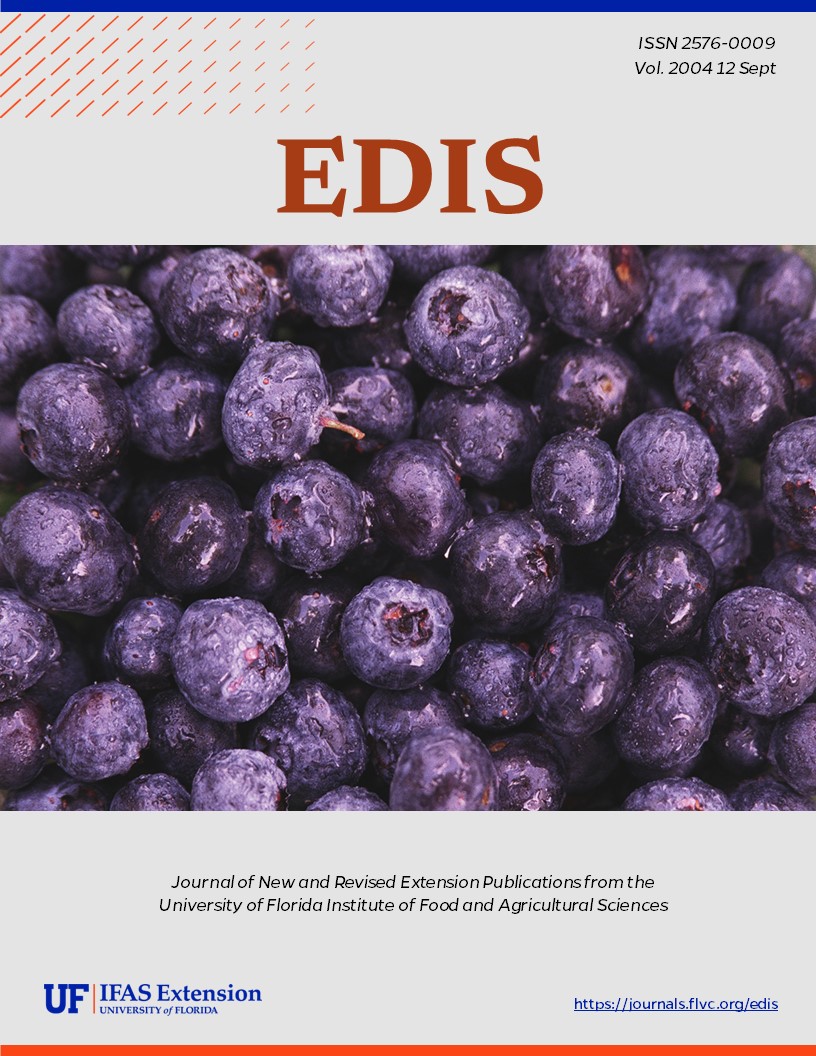Abstract
Thrips are serious pests of ornamental, vegetable, and fruit crops in the field and greenhouse. Feeding and egg-laying by thrips results in distortion, discoloration, silvering, and bronzing of leaves and fruits of vegetables reducing their market value. Some species of thrips are vectors of bunyaviruses (family Bunyaviridae, genus Tospovirus, type species Tomato spotted wilt). Severe epidemics occur annually on food, fiber, and ornamental crops in temperate, subtropical and tropical regions of the world. This document is ENY-658, one of a series of the Entomology and Nematology Department, Florida Cooperative Extension Service, Institute of Food and Agricultural Sciences, University of Florida. Date printed: March 2004.
ENY-658/IN401: Managing Thrips in Pepper and Eggplant (ufl.edu)
References
Bottenberg, H., G. Frantz, and H. Mellinger. 1999. Refuge and cover crop plantings for beneficial insect habitats. Proceedings of the Florida State Horticultural Society 112: 339-341.
Chellemi, D.O., J.E. Funderburk, and D.W. Hall. 1994. Seasonal abundance of flower inhabiting Frankliniella species (Thysanoptera: Thripidae) on wild plant hosts.Environmental Entomology 23: 337-342. https://doi.org/10.1093/ee/23.2.337
Etienne, J., J. Guyot, and X. van Waetermeulen. 1990. Effect of insecticides, predation, and precipitation on populations of Thrips palmi on aubergine (eggplant) in Guadeloupe.Florida Entomologist 73: 339-342. https://doi.org/10.2307/3494822
Funderburk, J.E., J. Stavisky, and S.M. Olson. 2000. Predation of Frankliniella occidentalis(Thysanoptera: Thripidae) in field peppers by Orius insidiosus (Hemiptera: Anthocoridae). Environmental Entomology 29: 376-382. https://doi.org/10.1603/0046-225X(2000)029[0376:POFOTT]2.0.CO;2
Funderburk, J.E., and J. Stavisky. 2004. Biology and economic importance of flower thrips. Document EBY682. Florida Cooperative Extension Service, Institute of Food and Agricultural Sciences, University of Florida, Gainesville. 6pp. https://doi.org/10.32473/edis-in415-2004
Immaraju, J.A., T.D. Paine, J.A. Bethke, K.L. Robb, and J.P. Newman. 1992. Western flower thrips (Thysanoptera: Thripidae) resistance to insecticides in coastal California greenhouses. Journal of Economic Entomology 85: 9-14. https://doi.org/10.1093/jee/85.1.9
Kajita, H., Y. Hirose, M. Takagi, S. Okajima, B. Napompeth, and S. Buranapanichpan. 1996. Host plants and abundance of Thrips palmi Karny (Thusanoptera: Thripidae), an important pest of vegetables in southeast Asia. Applied Entomology and Zoology 31: 87-94. https://doi.org/10.1303/aez.31.87
Kucharek, T., L. Brown, F. Johnson, and J. Funderburk. 1990. Tomato spotted wilt virus of agronomic, vegetable, and ornamental crops. Florida Cooperative Extension Service, Plant Pathology Department circular 914, 10pp.
Peters, D. 1998. An updated list of plant species susceptible to tospoviruses, pp.107-110. In: Recent Progress in Tospovirus and Thrips Research. Proceedings of the Fourth International Symposium on Tospoviruses and Thrips in Floral and Vegetable Crops.Wageningen, The Netherlands.
Ramachandran, S., J.E. Funderburk, J. Stavisky, and S.M. Olson. 2001. Population abundance and movement of Frankliniella species and Orius insidiosus in field pepper. Agricultural and Forest Entomology 3: 129-137. https://doi.org/10.1046/j.1461-9563.2001.00097.x
Salguero-Navas, V.E., J.E. Funderburk, R.J. Beshear, S.M. Olson, and T.P. Mack. 1991. Seasonal patterns of Frankliniella spp. (Thysanoptera: Thripidae) in tomato flowers. Journal of Economic Entomology. 84:1818-1822. https://doi.org/10.1093/jee/84.6.1818
Sherwood, J.L., T.L. German, J.W. Moyer, D.E. Ullman. 2000. Tospoviruses.In Encyclopedia of Plant Pathology, ed. O.C. Moloy and T.D. Murray.John Wiley and Sons, Inc., New York, NY.
Toapanta, M., J.E. Funderburk, S. Webb, D.O. Chellemi, and J. Tsai. 1996. Abundance of Frankliniella spp. (Thysanoptera: Thripidae) on winter and spring host plants. Environmental Entomology 25: 793-800. https://doi.org/10.1093/ee/25.4.793
Tsai, J.H., B.Yue, S.E. Webb, J.E. Funderburk, and H.T. Hsu. 1995. Effects of host plant and temerature on growth and reproduction of Thrips palmi (Thysanoptera: Thripidae). Environmental Entomology 24: 1598-1603. https://doi.org/10.1093/ee/24.6.1598
Tsai, J.H., B.S. Yue, J.E. Funderburk, and S.E. Webb. 1996. Effect of plant pollen on growth and reproduction of Frankliniella bispinosa.Acta Horticulturae 431: 535-541. https://doi.org/10.17660/ActaHortic.1996.431.50
Unless otherwise specified, articles published in the EDIS journal after January 1, 2024 are licensed under a Creative Commons Attribution-NonCommercial-NoDerivs 4.0 International (CC BY-NC-ND 4.0) license.

